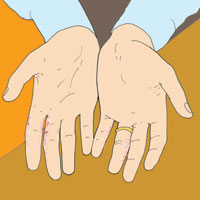

 At the Update Pharmacy, a man has asked at the medicines counter for antihistamine cream for itchy blisters on his hands and has been referred to pharmacist David Spencer.
At the Update Pharmacy, a man has asked at the medicines counter for antihistamine cream for itchy blisters on his hands and has been referred to pharmacist David Spencer.
In the consultation area David looks at the man’s hands and sees a series of clear, deep-seated, tapioca-like vesicles on the sides of two or three fingers on both hands and one or two in each palm.
“You say these are very itchy,” David says. “The surrounding skin looks a bit inflamed too. How long have you had this?”
“It started a couple of days ago. It began with a sort of burning feeling and then these blisters started appearing.”
“Have you got any ideas about what might have caused it?”
“I thought at first it might be insect bites or something, but I haven’t been out doing gardening or anything like that.
“My wife thought it might be scabies; she said a friend’s kiddie had had it and it started with itching between the fingers.”
“Have you had anything like this before?” David asks.
“No.”
“This may sound like a strange question, but have you got anything like this on your feet?”
“No. Why, do you think it’s a sort of athlete’s foot?”
“No.” David replies. “Do you suffer with asthma or eczema or have any allergies?”
“I do get hay fever in the early summer, but it’s autumn now.”
“Well,” says David, “I think I know what it might be, but what to treat it with is a bit of a problem.”
Questions
1. What does David think the man’s condition is? How common is it? What are its main clinical features?
2. What is/are the causes?
3. Why does David say that treating it is a bit of a problem?
Answers
1. Pompholyx, a form of dermatitis. It accounts for around 5 per cent of cases of eczema of the hand. The usual age of those affected is 20 to 40, but it can affect teenagers and older people. There is a female preponderance of 2:1. The blisters occur mainly on the palms of the hands and sides of the fingers and hands, but the soles of the feet can also be involved. Blisters normally resolve spontaneously in three to four weeks. The condition may be acute, chronic or recurrent.
2. The aetiology is unknown, but there are a number of commonly identified aggravating factors, including emotional stress and allergens such as chromate, nickel and quinolones. Many other possible triggers have been suggested.
3. Pompholyx is difficult to treat effectively. Steroid creams are often prescribed to treat the itching. Use of OTC hydrocortisone or clobetasone cream is within the licensing conditions and could be used for up to one week. Systematic antihistamines could also be tried. A number of treat-ments have been used by derma-tologists for severe or recurrent pompholyx, including the immuno-supressants azathioprine and meth-otrexate, retinoids, the tumor necrosis factor-alpha inhibitor etanercept, and UV and PUVA therapies.
Main reference
Wollina U. Pompholyx: A Review of Clinical Features, Differential Diagnosis, and Management. Am J Clin Dermatol. 2010;11:305-314.

